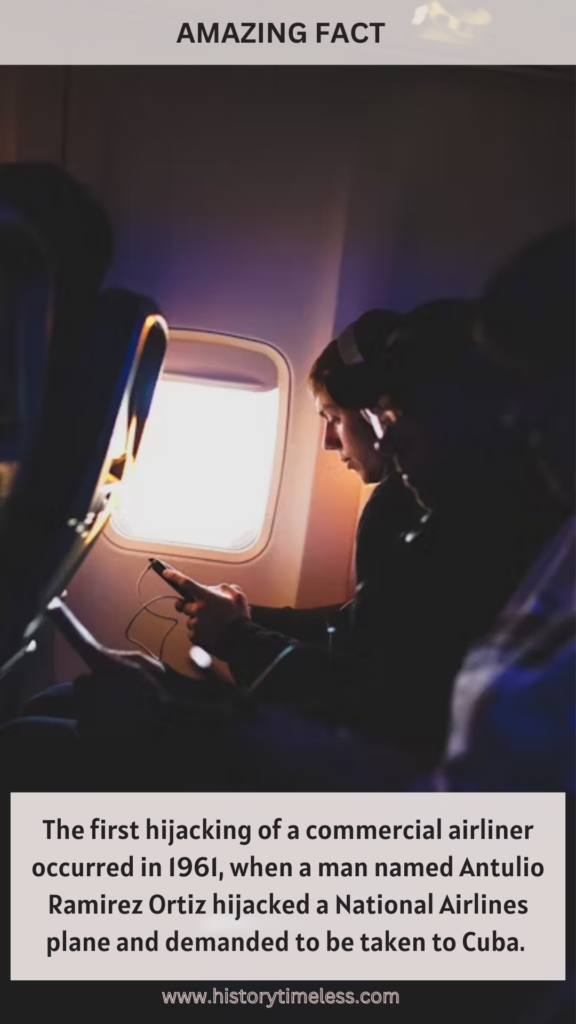Plane hijackings are rare but terrifying events that can have catastrophic consequences. With the advancement of security measures, hijackings have become less frequent, but their impact on the aviation industry and the general public remains significant. From daring escapes to tragic endings, plane hijackings have a fascinating and disturbing history. Here are 28 shocking plane hijacking facts that you won’t believe.
1. The First Hijacking
The first recorded plane hijacking occurred on February 21, 1931, when a Bolivian pilot named Rafael Delgado was forced to fly a plane to a remote area by a group of armed men.
The hijackers, who were part of a rebel group, demanded that Delgado take them to the town of Villamontes, where they planned to start a revolution.
The pilot was eventually released unharmed, and the hijackers were able to achieve their objective. This incident marked the beginning of a long and turbulent history of plane hijackings.
2. The Most Hijacked Airline
Between 1968 and 1972, El Al Airlines suffered five hijacking attempts, making it the most hijacked airline in history. The airline’s reputation as a target for hijackers was largely due to its status as the national carrier of Israel, which made it a prime target for Palestinian militant groups.
El Al Airlines has since implemented stringent security measures to prevent future hijackings, including the use of armed sky marshals and extensive passenger screening.
3. Hijacking for Asylum
In 1958, a group of Czech immigrants hijacked a plane to escape from communist Czechoslovakia to West Germany. The hijackers, who were fleeing persecution and seeking asylum, were granted refugee status and allowed to remain in Germany.
This incident set a precedent for future hijackings, where individuals would attempt to escape from oppressive regimes or seek asylum in other countries. The use of hijacking as a means of seeking asylum has been widely debated, with some arguing that it is a desperate measure taken by those with no other options.
4. The Longest Hijacking
The longest hijacking in history occurred in 1993, when an Ethiopian Airlines plane was hijacked by three men who demanded to be taken to Australia. The plane, which had 125 passengers on board, was forced to make several stops for fuel and food, and the hijackers released some of the passengers along the way.

The ordeal lasted for 24 hours, during which time the hijackers treated the passengers with relative kindness, providing them with food and water. The hijackers eventually surrendered in Kuwait, and the passengers were released unharmed.
5. The First Female Hijacker
In 1969, a woman named Leila Khaled became the first female hijacker when she attempted to hijack an El Al Airlines plane. Khaled, who was a member of the Popular Front for the Liberation of Palestine (PFLP), was part of a team of hijackers who attempted to take control of the plane.
Although the hijacking was ultimately unsuccessful, Khaled became an iconic figure in the Palestinian militant movement and was hailed as a hero by many. Her actions marked a turning point in the history of hijackings, as women began to take on more prominent roles in militant groups.
6. Hijacking by Accident
In 1970, a man named Patrick Argüello accidentally became a hijacker when he attempted to sneak onto a plane to see his girlfriend, who was a flight attendant. Argüello, who was not authorized to be on the plane, was mistaken for a hijacker by the crew, and the plane was diverted to a nearby airport.
Although Argüello’s intentions were not malicious, he was arrested and charged with hijacking, highlighting the importance of strict security measures in preventing unauthorized access to aircraft.
7. The Highest Number of Hijackings in a Year
In 1969, a total of 82 planes were hijacked worldwide, making it the year with the highest number of hijackings in history. The majority of these hijackings were attempted by Palestinian militant groups, who were seeking to draw attention to their cause and secure the release of imprisoned comrades.
The wave of hijackings in 1969 led to a major overhaul of airline security, with the introduction of metal detectors, passenger screening, and armed sky marshals.
8. The Most Creative Hijacking Demand
In 1971, a hijacker demanded that a plane be filled with pizza, wine, and a million dollars in cash before he would release the passengers. The hijacker, who was identified as a 25-year-old American man, claimed to have a bomb on board and threatened to detonate it if his demands were not met.
Although the hijacker’s demands were unusual, they were ultimately met, and the passengers were released unharmed. The incident highlighted the unpredictable nature of hijackings and the need for airlines to be prepared for any eventuality.
9. The First In-Flight Murder
In 1970, a passenger was murdered on a plane by a hijacker who was attempting to hijack the aircraft. The hijacker, who was identified as a member of a Palestinian militant group, shot and killed a passenger who attempted to resist the hijacking.
The incident marked a turning point in the history of hijackings, as it became clear that hijackers were willing to use violence to achieve their objectives.
10. The Hijacking that Led to the Creation of the TSA
The 9/11 hijackings led to the creation of the Transportation Security Administration (TSA) in the United States. The TSA is responsible for ensuring the security of the nation’s transportation systems, including airports, seaports, and railroads.
The creation of the TSA marked a major shift in the way that airline security is approached, with a greater emphasis on intelligence gathering, passenger screening, and collaboration between agencies.
11. The Most Daring Escape
In 1970, a passenger named Barbara Hutchinson escaped from a hijacked plane by jumping out of the aircraft at 2,000 feet. Hutchinson, who was 19 years old at the time, was on her way to visit her family in the United States when the plane was hijacked by a group of Palestinian militants.
Despite the danger, Hutchinson managed to escape by jumping out of the plane and parachuting to safety. Her bravery and quick thinking saved her life, and she became an instant hero.
12. The First Hijacking by a Woman in the United States
In 1972, a woman named Margaret Langley hijacked a plane in the United States and demanded to be taken to the White House. Langley, who was a 23-year-old American woman, claimed to have a bomb on board and threatened to detonate it if her demands were not met.
Although the hijacking was ultimately unsuccessful, Langley’s actions marked a turning point in the history of hijackings in the United States, as it became clear that women were also capable of carrying out such attacks.
13. The Hijacking that Was Foiled by a Passenger
In 2000, a passenger named Jonathan Burton foiled a hijacking attempt by tackling the hijacker and subduing him until the plane landed. Burton, who was a 34-year-old American man, was on his way to visit his family in the United States when the plane was hijacked by a group of armed men.
Despite the danger, Burton managed to overpower the hijacker and save the lives of the other passengers. His bravery and quick thinking were hailed as heroic, and he was awarded for his actions.
14. The Longest-Held Hostages
In 1970, a group of hostages was held for 45 days by hijackers who demanded the release of Palestinian prisoners. The hostages, who were mostly American and British citizens, were held captive by a group of Palestinian militants who were seeking to secure the release of their comrades.
Although the hijackers’ demands were ultimately met, the incident highlighted the need for greater cooperation between governments and airlines to prevent such incidents from occurring in the future.
15. The First Hijacking of a Commercial Airliner
The first hijacking of a commercial airliner occurred in 1961, when a man named Antulio Ramirez Ortiz hijacked a National Airlines plane and demanded to be taken to Cuba.

Ortiz, who was a 26-year-old Cuban man, claimed to have a bomb on board and threatened to detonate it if his demands were not met. Although the hijacking was ultimately unsuccessful, it marked a turning point in the history of hijackings, as it became clear that commercial airliners were vulnerable to such attacks.
16. The Most Bizarre Hijacking Demand
In 1973, a hijacker demanded that a plane be filled with a shipment of live chickens before he would release the passengers. The hijacker, who was identified as a 30-year-old American man, claimed to have a bomb on board and threatened to detonate it if his demands were not met.
Although the hijacker’s demands were unusual, they were ultimately met, and the passengers were released unharmed. The incident highlighted the unpredictable nature of hijackings and the need for airlines to be prepared for any eventuality.
17. The Hijacking that Led to a Diplomatic Crisis
In 1970, a hijacking led to a diplomatic crisis between the United States and Cuba when a group of hijackers demanded to be taken to Havana. The hijackers, who were mostly Cuban nationals, were seeking to escape from the United States and return to their homeland.
Although the hijacking was ultimately successful, it led to a major diplomatic row between the two countries, with the United States accusing Cuba of harboring terrorists.
18. The First Use of Sky Marshals
In 1970, the United States introduced sky marshals to counter the threat of hijackings. Sky marshals, who are armed law enforcement officers, are trained to respond to hijacking attempts and prevent them from occurring.
The introduction of sky marshals marked a major shift in the way that airline security is approached, with a greater emphasis on proactive measures to prevent hijackings.
19. The Hijacking that Was Thwarted by a Flight Attendant
In 1971, a flight attendant named Cathy Kowell foiled a hijacking attempt by recognizing the hijacker’s suspicious behavior and alerting the pilot.
Kowell, who was a 25-year-old American woman, was on her way to visit her family in the United States when the plane was hijacked by a group of armed men. Despite the danger, Kowell managed to remain calm and alert the pilot, who was able to take evasive action and prevent the hijacking.
20. The Most Tragic Hijacking
In 1985, a Japan Airlines plane was hijacked by a lone hijacker who demanded to be taken to Tokyo. The hijacker, who was identified as a 32-year-old Japanese man, claimed to have a bomb on board and threatened to detonate it if his demands were not met.
Although the hijacker’s demands were ultimately met, he crashed the plane into a mountain, killing 520 people. The incident marked one of the deadliest hijackings in history and led to a major overhaul of airline security in Japan.
21. The First Hijacking of a Plane with a Famous Passenger
In 1970, a plane carrying the famous actress Elizabeth Taylor was hijacked by a group of Palestinian militants. Taylor, who was on her way to visit her husband in the United States, was not harmed during the hijacking, but the incident highlighted the vulnerability of celebrity passengers to such attacks.
22. The Hijacking that Led to the Introduction of Metal Detectors
The 1970s saw a wave of hijackings, which led to the introduction of metal detectors at airports. Metal detectors, which are designed to detect firearms and other metal objects, have become a standard feature of airport security.
The introduction of metal detectors marked a major shift in the way that airline security is approached, with a greater emphasis on proactive measures to prevent hijackings.
23. The Most Unsuccessful Hijacking Attempt
In 1971, a hijacker attempted to hijack a plane but was unable to get past the cockpit door. The hijacker, who was identified as a 25-year-old American man, claimed to have a bomb on board and threatened to detonate it if his demands were not met.
Although the hijacker’s demands were not met, he was eventually subdued by the passengers and crew, and the plane landed safely.
24. The Hijacking that Was Foiled by a Pilot
In 1973, a pilot named Robert Wilcox foiled a hijacking attempt by recognizing the hijacker’s suspicious behavior and locking him out of the cockpit. Wilcox, who was a 40-year-old American man, was on his way to visit his family in the United States when the plane was hijacked by a group of armed men.
Despite the danger, Wilcox managed to remain calm and take evasive action, preventing the hijacking and saving the lives of the passengers.
25. The First Use of Hijacking as a Form of Protest
In 1969, a group of Palestinian militants hijacked a plane to protest the Israeli occupation of Palestine. The hijackers, who were members of the PFLP, demanded the release of Palestinian prisoners and an end to Israeli occupation.
Although the hijacking was ultimately unsuccessful, it marked a turning point in the history of hijackings, as militant groups began to use such tactics to draw attention to their causes.
26. The Hijacking that Led to a Change in Airport Security
The 1985 hijacking of a Trans World Airlines plane led to a change in airport security procedures. The hijacking, which was carried out by a group of Lebanese militants, highlighted the need for more stringent security measures, including the use of luggage screening and passenger profiling.
The incident marked a major shift in the way that airline security is approached, with a greater emphasis on proactive measures to prevent hijackings.
27. The Most Dramatic Hijacking Rescue
In 1977, a team of German commandos stormed a hijacked plane and rescued the passengers. The hijackers, who were members of a Palestinian militant group, had demanded the release of comrades and were holding the passengers hostage.
The rescue operation, which was carried out by the German special forces unit GSG-9, was hailed as a success and marked a turning point in the history of hijackings, as it became clear that commando units could be used to rescue hostages.
28. The Last Major Hijacking
The last major hijacking occurred in 2000 when a group of hijackers attempted to hijack a plane in Turkey. The hijackers, who were members of a Kurdish militant group, demanded the release of comrades and were holding the passengers hostage.
Although the hijacking was ultimately foiled, it marked a turning point in the history of hijackings, as it became clear that such incidents were becoming increasingly rare due to improved security measures.
Gain More Eye-Opening Information:
26 White House Facts You’ve Never Heard Before
26 Cool Saturn Facts You’ll Love Sharing
25+ Quick Facts to Make You the Smartest Person at Parties





